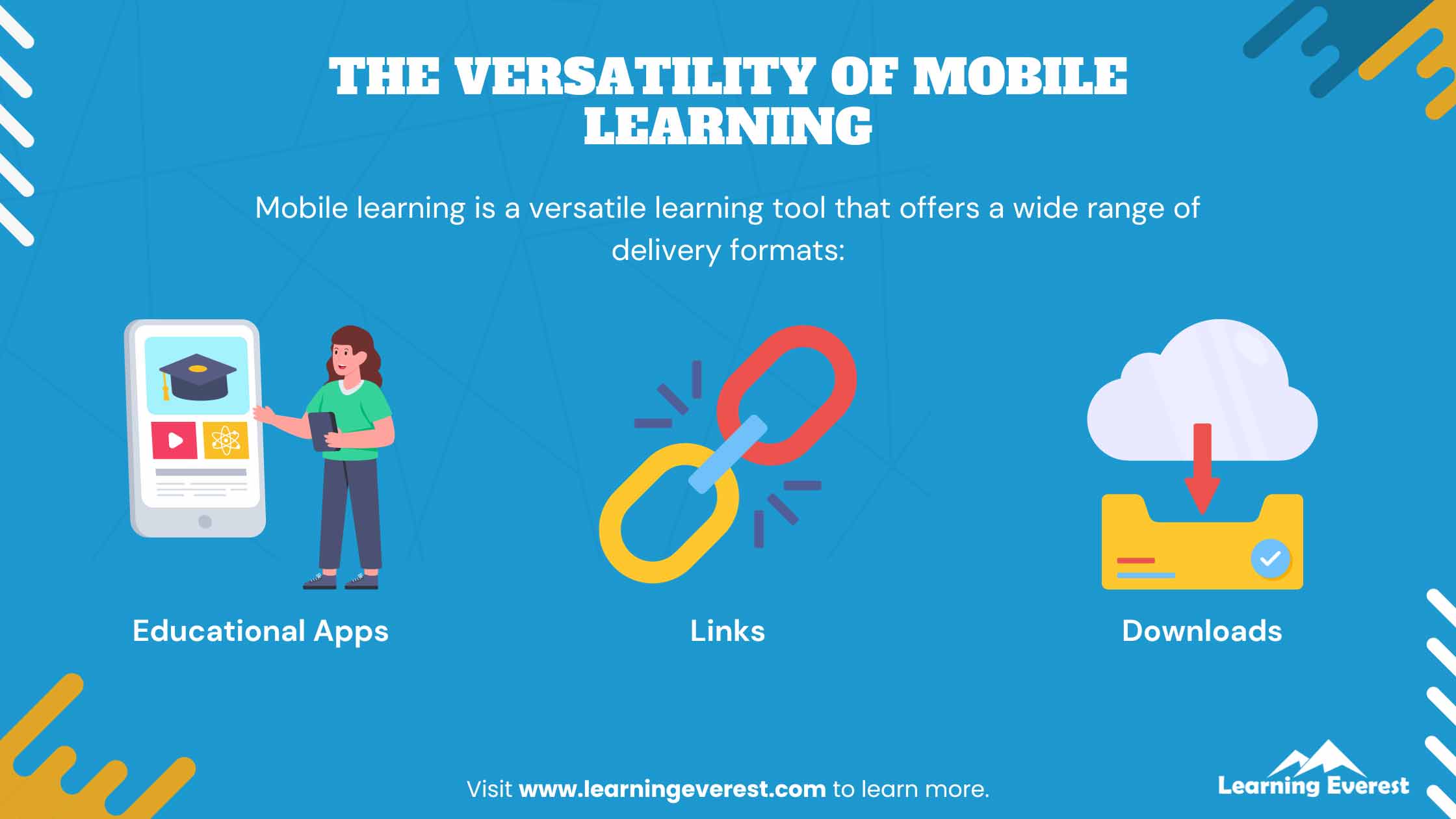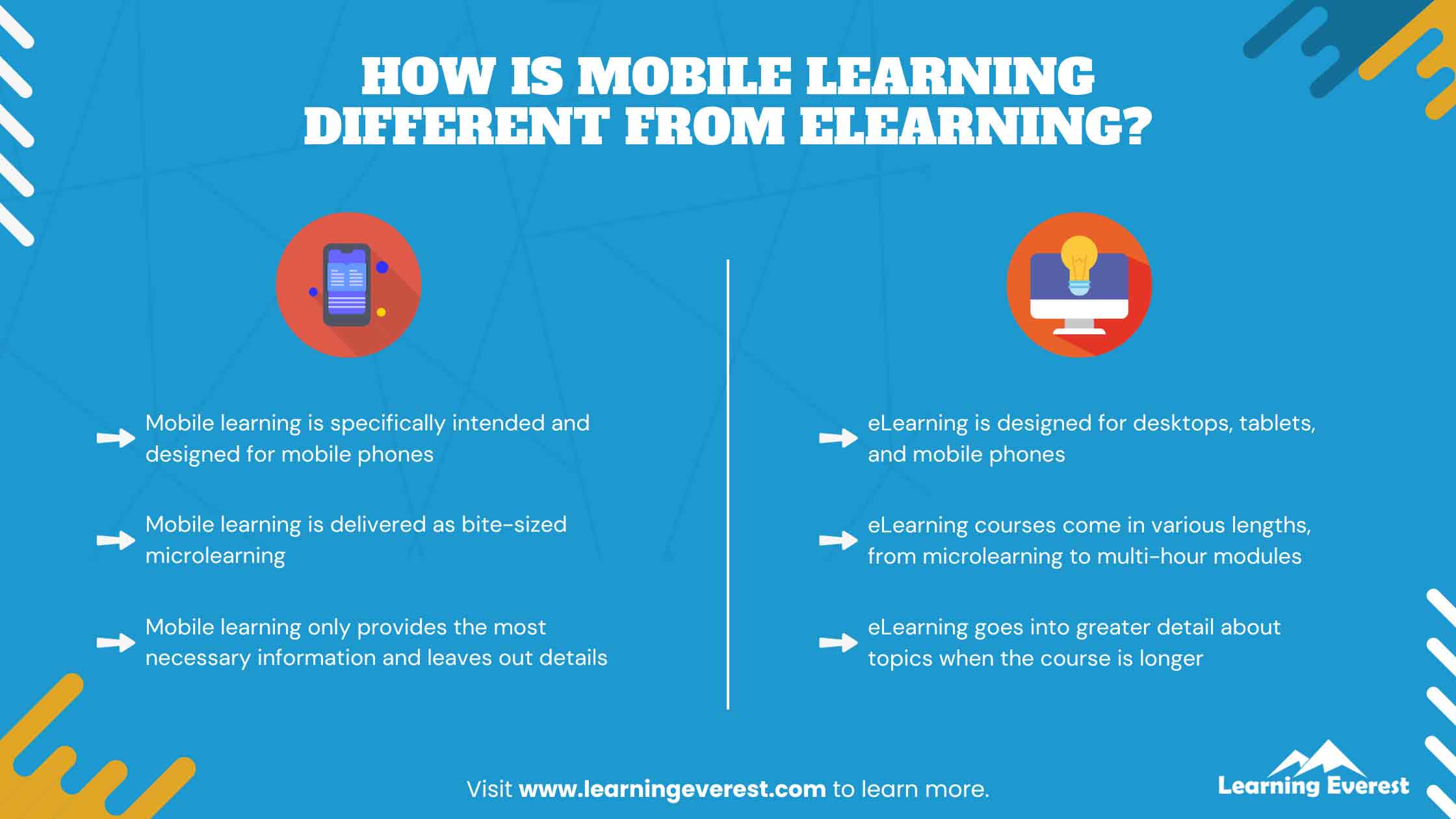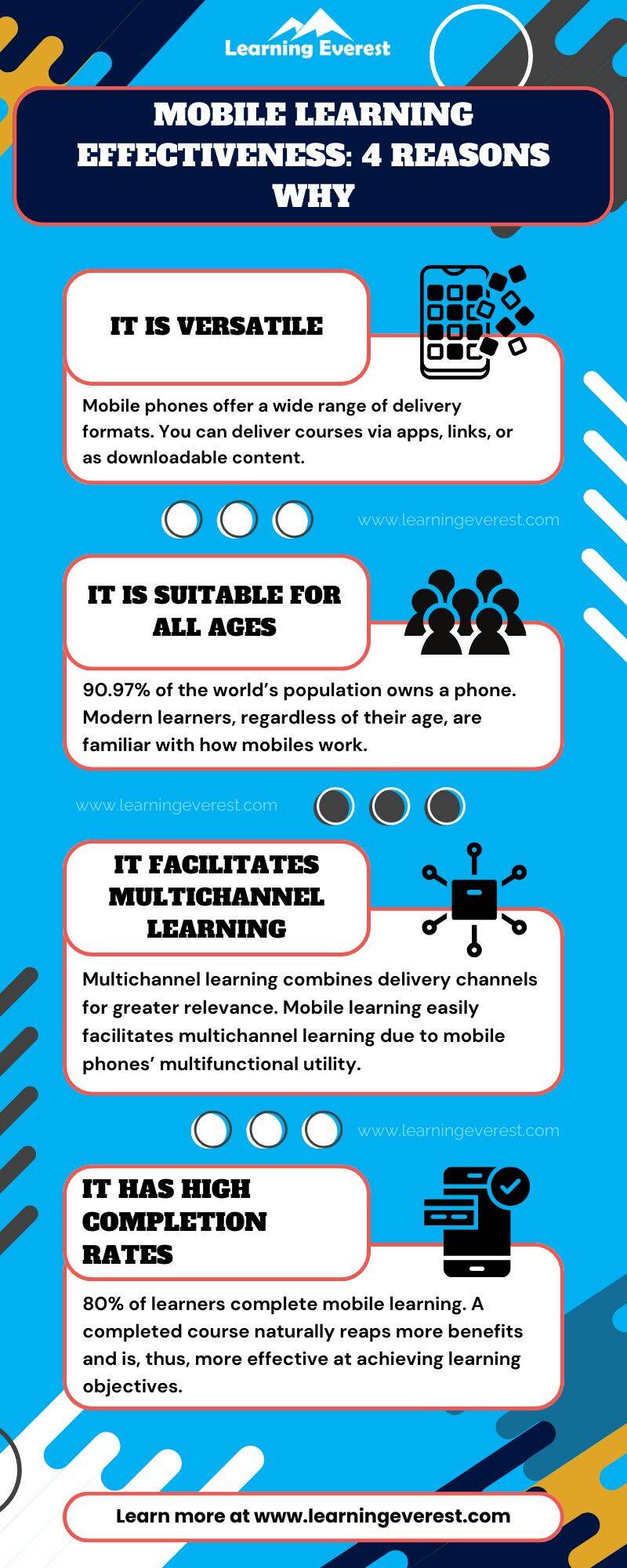Mobile learning has gained massive traction in recent years with all types of learners. Its convenience and efficacy are a combination learners highly appreciate. However, mobile learning effectiveness is not just a given. It takes deliberate design to bring the best out of this medium. This article breaks down why mobile learning is quickly becoming the preferred mode of learning for many and what it gets right.
Table of Contents
- Mobile Learning’s Growth and Adoption
- Mobile Learning Effectiveness
- Mobile Learning Effectiveness – Reason 1: It is Versatile
- Mobile Learning Effectiveness – Reason 2: Mobile Learning Has Higher Completion Rates
- Mobile Learning Effectiveness – Reason 3: Mobile Learning is Suitable for All Age Groups
- Mobile Learning Effectiveness – Reason 4: It Facilitates Multichannel Learning
- Conclusion
- Infographic
- Knowledge Check!
- Frequently Asked Questions (FAQs)
- What are the advantages of mobile learning?
- How is mobile learning effective in education?
- What are the characteristics of mobile learning?
Mobile Learning’s Growth and Adoption
The past decade has seen a rapid increase in mobile phone ownership and use. According to Statista.com, there are 7.33 billion mobile users in the world. Out of these, 6.92 billion users have smartphones. In other words, 90.97% of the world’s population possesses a mobile phone today,
As mobile phones have become ubiquitous, the adoption and demand for mobile learning has also increased. Current estimates suggest that the mobile learning market will grow from $60.97 billion in 2023 to $164.42 billion in 2028 (Source: Mordor Intelligence LLP).
Additionally, BYOD policies, remote workplaces and classrooms, and improved smartphone functionalities have all made mobile learning more relevant than ever before.
Mobile Learning Effectiveness
Let us delve into what makes mobile learning effective.
Mobile Learning Effectiveness – Reason 1: It is Versatile
Mobile phones offer a wide range of delivery formats, making it a good fit for all training needs. You can deliver courses via apps, through links, or as downloadable content that learners can store and consume offline. Learners seem to be well aware of this, as 30% of smartphone users use their phones for educational purposes (Source: EduMe).

The Versatility of Mobile Learning
Educational Apps
Educational applications are mobile apps that are specifically built to relay information to learners in a structured manner. They typically have modules and lessons learners can consume in a linear order to gain knowledge and skills related to a specific topic.
Educational apps come in all shapes and sizes. They can be LMS that track learners’ progress and assign them content depending on pre-requisites, or content libraries learners have complete access to.
Since users spend 91% of their mobile screen time on apps (Source: EduMe), it is no surprise that mobile learning apps have become incredibly common. Most businesses, educational institutions, and commercial online learning platforms today have a mobile app for learners.
There are also specialized learning apps that focus on a single domain, such as language learning, mathematics, coding, etc. These apps are more specific in their scope.
Lastly, many educational apps specifically cater to children and build social skills, speech, and foundational knowledge of numbers, alphabets, etc. in an engaging manner.
Hence, by catering to multiple learner groups, educational apps increase mobile learning effectiveness.
Links
Links add to the versatility of mobile learning by distributing learning materials like articles, PDFs, drive folders, videos, and more to learners without going through the effort of building a custom platform. This simplicity extends to learners, too, since they can view most links on their default browser or preloaded applications, saving them device space.
Downloadable Content
Downloadable content significantly adds to mobile learning effectiveness and versatility by allowing learners to learn from anywhere, regardless of whether they have a reliable internet connection or not. This is especially useful for on-the-go learning for learners who travel a lot for work or have long transport times to and from work. Downloadable content gives learners the flexibility to utilize downtime efficiently and decide when they want to learn.
Mobile Learning Effectiveness – Reason 2: Mobile Learning Has Higher Completion Rates
80% of learners complete mobile learning (Source: Teach on Mars). Mobile learners also complete courses 45% faster (Source: Lynda.com), decreasing their chances of quitting halfway. A completed course naturally reaps more benefits and is, thus, more effective at achieving learning objectives and business goals.
Hence, mobile learning is better than traditional eLearning at engaging modern learners and meeting their learning preferences.

How is Mobile Learning Different from eLearning
Mobile Learning Effectiveness – Reason 3: Mobile Learning is Suitable for All Age Groups
Another reason behind the effectiveness of mobile learning is its suitability for all age groups. Going back to the mobile phone ownership statistics mentioned earlier in the article, 90.97% of the world’s population owns a mobile phone. Modern learners, regardless of their age, are familiar with how mobiles work.
When it comes to executing tasks, smartphones have a more straightforward process than desktops, making them more intuitive. Additionally, all learners use their phones multiple times a day for a variety of tasks but might use their desktops for very specific tasks without exploring other functionalities.
Thus, there is a possibility of encountering learner groups who are comfortable using mobile phones but are not as savvy with computers.
Here’s why this is significant: effective learning eliminates as many learner barriers as possible. In eLearning, the usability of a learning experience can hinder how well learners absorb the content, making it a potential barrier.
A familiar delivery medium removes barriers to usability, making it easier for learners to understand the content. In fact, 64% of learners consider mobile device accessibility important in eLearning. Furthermore, 70% of learners reported improved motivation to learn when they could use their mobile devices to take courses (Source: ShiftLearning).
Although a well-designed eLearning course can work around such barriers for all device types, it requires greater time and money. Mobile learning provides a viable alternative in such situations that is much quicker and cheaper to execute and deploy without compromising on the quality of learning.
Mobile Learning Effectiveness – Reason 4: It Facilitates Multichannel Learning
Mobile phones are highly efficient utility devices that serve a variety of functions. They can be used to view images, watch videos, listen to audio, read documents, and take audio and video calls. This is a notable strength, as it adds to mobile learning effectiveness by promoting multichannel learning.
Multichannel learning is learning provided by blending various channels of delivery. For instance, an eLearning program that combines virtual instructor-led sessions, short gamified quizzes, and self-learning readings. Social and peer learning are also vital components of this approach.
Multichannel learning is a fairly new concept in eLearning. It is based on the principle that when learners receive multiple instances of the same information from one channel, they are more likely to be able to apply that knowledge. Multichannel learning leverages this by matching learning channels with learners’ preferences.
Mobile learning easily facilitates multichannel learning due to mobile phones’ multifunctional utility, making it a powerful tool for providing more relevant learning that is aligned with learner preferences.
Conclusion
The way learners consume and engage with educational content has seen a shift in recent years. Due to the central role mobile phones play in modern lives, users have come to depend on them for various everyday tasks. This includes learning. Luckily, the extensive utility smartphones provide add to the mobile learning effectiveness instead of taking away from it, making them a great tool for knowledge and skill development.
Infographic

Mobile Learning Effectiveness 4 Reasons Why
Knowledge Check!
What are the advantages of mobile learning?
Mobile learning has many advantages. Some of them include:
- It is convenient yet effective
- It combines multiple learning formats
- Learners complete mobile learning faster than traditional eLearning
How is mobile learning effective in education?
Mobile learning is effective in education due to the following reasons:
- It is versatile
- It has high completion rates
- It is suitable for learners of all ages
- It provides multichannel learning
What are the characteristics of mobile learning?
Mobile learning is learning delivered through a mobile device, usually a smartphone. It takes deliberate design to bring the best out of this medium.





